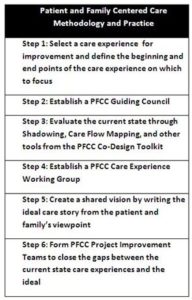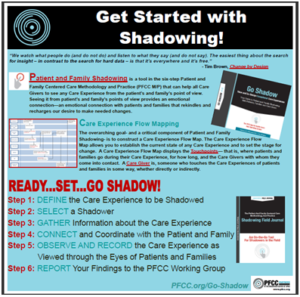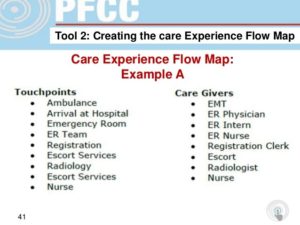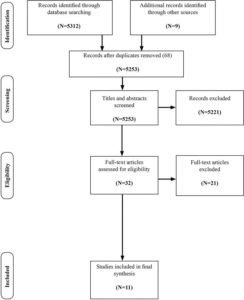
“Developments in medical technology have long been confined to procedural or pharmaceutical advances, while neglecting a most basic and essential component of medicine: patient information management.”
– John Doolittle, American Politician
Why Do You Need Patient Shadowing?
The patient’s journey through the healthcare delivery process can be full of good and bad experiences, which remain unknown to the healthcare providers as most patients are often reluctant or intimidated to raise their voices against medical facilities. Individuals involved in some form of healthcare services – doctors, nurses, attendants, dieticians, and other administrative staff engaged in hospitals or patient-care facilities – often make evaluations about the quality of healthcare services from their own perspectives. To better understand the actual outcomes of healthcare services, a six-step procedure known as the Patient and Family Centered Care Methodology and Practice (PFCC M/P) was developed in 2006 by Anthony M. DiGioia, III, M.D., in Pittsburgh, PA. The article titled Listen and learn: Patient experiences hold the key to better care offers a useful overview of the PFCC program.

Source: Pinterest – PFCC- Six-Step Practice
The PFCC M/P Program for Patient-Centric Healthcare
The PFCC M/P program places the patient and family members at the forefront, enabling them to critique, judge, and evaluate the healthcare they receive objectively. The broad objective of the Patient Shadowing tool is to enable the health service-providers or care givers to experience the patient experience firsthand. By shadowing a patient, the doctor, nurse, medical student, or a medical attendant can observe, interact, and learn how the patient is receiving the healthcare, and immediately discover “gaps” in the existing care processes. In other words, patient shadowing is a great step towards understanding the problems faced by patients while receiving the care, and making necessary improvements in the care process. The aim of the PFCC program is to collect patient response data, analyze, and report patient response data to find gaps between “ideal care” and “actual care.” Moreover, the shadowing exercise helps the care givers to forge a direct bond with the patients and their close family members. Though Patient Shadowing, the care provider, patients, and their families become partners or co-designers of improved care processes.
During patient shadowing, the care giver follows, observes, and interacts with the patient to find out in details the actual healthcare benefits or lapses from the patients themselves. During shadowing, care givers make notes, which they later analyze to prepare reports about improving the existing processes. The direct feedback and qualitative judgments provided by the patients help the care givers to see the benefits and lapses from the other side – the patient’s view.
The Six Defined Steps of PFCC: A Holistic Evaluation of Care Delivery

Source: PFC.org/Go-Shadow
Though healthcare providers can suitably modify the steps outlined here based on their actual needs and objectives in a particular situation, the basic steps in PFCC are:
- Defining the care process or experience to be shadowed.
- Selecting Shadower/Shadowers
- Acquiring sufficient information about the process to be shadowed
- Making contact with the patient and family members to get permission for shadowing
- Observing, Interacting, and Recording patient experience from the patient’s view
- Reporting the Findings or results to the PFCC Working Group and relevant project teams
The procedure just described above helps the primary caregivers and other healthcare staff to develop an empathetic view of care services, and also provides a sense of urgency to bring about the much needed changes in the existing care processes. However, Patient Shadowing can be employed standalone to get valuable insights about existing care processes.
One common concern among health researchers and practitioners is that selecting good candidates for “care experiences” to be included in a PFCC program may not be easy and can potentially contain undesirable biases that can be countered by the presence of patients in the selection teams. The Semantic Scholar report titled What is the potential of patient shadowing as a patient-centered method? explains this problem and the probable solution very well.
Remedial Healthcare in Action: Viewing, Observing, and Note-Taking During Patient Shadowing
According to Pamela Greenhouse, MBA, who serves as the executive director, Patient and Family Centered Care Innovation Center (PFCC), University of Pittsburgh Medical Center (UPMC):
“Health care providers should view all care as an experience through the eyes of patients and families. Our goal is to help patients, families and health care providers learn from each other and partner to co-design ideal care delivery.”
Greenhouse feels that the six-step PFCC M/P program can help break “organizational silos,” and bring about collaborative solutions to challenges facing existing care processes in different parts of any healthcare center. During shadowing, the provision for immediate response from patients, can drive change must faster than any other healthcare-process remedial method.

Source: PFCC – Pamela Greenhouse on Slide share
goShadow app for Patient Shadowing
In PFCC, the goShadow® app has been widely used to aid the shadowing journey from beginning to end. The go Shadow® app is a nifty Shadowing App, which delivers a “low cost” but high impact” solution to professionals across industry sectors to define, observe, report, and improve their processes. The ultimate goal is not to find some miraculous, overnight quality solution, but to bring about gradual process improvements through repeated use of Shadowing process. The go Shadow® app may be used in to gain 360 degrees view of the customer, to build and sustain a team in any sector, to manage business resources in real time, and finally to improve patient care processes. This app provides useful features to capture notes, analyze, report, and share results on both online and mobile platforms.
Use of Patient Shadowing for Healthcare Safety
Persons engaged in healthcare safety or quality process improvements will find Patient Shadowing one of the best available tools to get direct insights into the patient experience. During a typical hospital stay, patients are subjected to many types of diagnostic procedures, instruments, digital equipments, and supportive medical gadgets. In many cases, these mechanical devices fail, malfunction, or even cause physical damage to the patient. Unless an innovative technique such as Patient Shadowing is employed, these problems will go unnoticed and be ignored by hospital facilities. The article titled Patient and Family Shadowing: The Technique for Viewing and Co-Designing Exceptional Care Experiences with Patients and Families aptly describes the need for PFCC M/P framework for improving safety-related processes in healthcare facilities.
From Being Invisible and Powerless to Being Empowered: The Patient’s Story
The PFCC procedure is designed to make the entire healthcare delivery process more patient-centric. Till now, you have read about many medical malpractice cases, which have rendered the patients and their families completely powerless and victimized by healthcare providers. You can read how Patient Shadowing can not only help improve processes, but can also help in bringing down healthcare costs in the blog post titled Patient Shadowing: How to Reduce Costs While Improving the Patient Experience and Outcomes.
As the central protagonist in the healthcare journey, the patent can make judicious use of this opportunity called Patient Shadowing to voice their problems, concerns, or apprehensions without the fear of any repercussion.
Through patient shadowing, the healthcare providers can engage in a two-way dialogue between the provider and the receiver of care and focus on what the patients actually need rather than what the provider feels they need.
Experiencing healthcare delivery processes through the eyes of the patients and families provides the healthcare providers a unique opportunity to bring positive change. This Social Work Today news piece claims that the highest level of patient care can be achieved by traversing the healthcare journey of patients, right from the parking lot where they arrive in ambulances to the ICU units, where they receive life-changing treatments.
Review of Patient Experience Data Found in Studies
The ultimate goal of the PFCC program is to shift the focus of healthcare from the medical facility and the medical team to the patient. A popular quote by William Osler, the Canadian Scientist states
“The good physician treats the disease; the great physician treats the patient who has the disease.”
The NIH NCBI link titled Systematic review of approaches to using patient experience data for quality improvement in healthcare settings includes wide literature review of direct evidence found in “patient-reported” data indicating specific care experience metrics. These data have been collected from healthcare settings in the USA and Europe. This study calls for more research to enable better understanding of patient-experience data for care process improvement. Of the 11 studies included in the final version of the research report, three studies were selected from general practice, and the rest were selected from acute or chronic care facilities. The geographic expanse of the study includes North America, UK, and Netherlands. You can review the full report to find out how data was collected and used for process improvements in care facilities.

Source: NIH NCBI Study Report: Data Collection Flow chart
The Point of Care Foundation has shared its PFCC toolkit implementation in The Point of Care Foundation: Patient Shadowing. This literature mentions that 16 NHS organizations have collaborated to make PFCC a success, especially Tony DiGioia and other team members of the Innovation Center at the University of Pittsburgh Medical Center, who developed and shared the PFCC approach to improving healthcare delivery processes.
What Role Can Medical Students Play in Patient Shadowing?
A relatively recent phenomenon has been including medical students in patient shadowing teams to provide them with a direct opportunity to learn from the patient-centric care experiences. As this glorious opportunity was not available to the previous generations of doctors and care givers, the current crop of students can seize this golden chance to learn as much as they can be shadowing both the doctor and the patient. The author of the NCBI article titled Physician shadowing by college students: what do patients think? seems to indicate that though in spite of some initial concerns regarding the negative impact of students shadowing doctors during patient care, the patients did not feel any negative impact; rather, they noticed the benefits of being watched by medical students during care delivery. The patients, according to this article, felt that by showing doctors during care delivery, the students would become better doctors one day!
Another article titled Shadowing Physicians at UW School of Medicine discusses the system of shadowing patients by pre-med students during care delivery at the University of Washington School of Medicine. This article further explains how routinely shadowing physicians in specific disciplines can improve a students’ understanding of a future career in a medical discipline. This US News blog post – Lessons from In- and Outpatient Shadowing Experiences clarifies why outpatient shadowing may be more desirable for medical student than in-patient shadowing as outpatient settings are less complicated and treat simple cases. In this setting, the attending physician will also be more willing to share treatment experience with the student.
Conclusion
As you must be convinced by now, that Patient Shadowing is a well-designed methodology for following healthcare delivery practices in real time, observing and noting patient emotions, reactions, and feedback, then analyzing the patient response data to find gaps between “ideal care” and “actual care.” This practice has helped in improving existing treatment and care processes in medical facilities in the US, the UK, and some other countries. As of now, available literature indicates clinical care processes used for children with acute asthma have seen major revisions due to PFCC. PFCC has also been applied to patients with dementia and their families to better understand the existing care process for such patients.
This shadowing practice can also be extended to other industry sectors such as retail, manufacturing, or food processing to improve existing processes over time.
“Electronic medical records are, in a lot of ways, I think the aspect of technology that is going to revolutionize the way we deliver care. And it’s not just that we will be able to collect information, it’s that everyone involved in the healthcare enterprise will be able to use that information more effectively.”
Risa Lavizzo-Mourey – American Businesswomen






